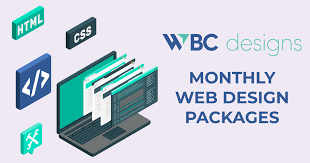Designing a website is not a one-and-done task—especially when it comes to monthly web design. In a constantly evolving digital world, keeping your website fresh and engaging is essential to maintain user interest and meet the demands of a competitive online marketplace. But finding inspiration month after month for new design updates can be a challenge.
In this article, we’ll explore some of the best places to find inspiration for your monthly web design projects, so you can keep your site looking modern and engaging for users.
Why Inspiration is Important for Monthly Web Design
Before we dive into the sources of inspiration, it’s important to understand why inspiration is crucial in monthly web design. Updating your website regularly helps keep your audience engaged, improves SEO, and keeps you ahead of competitors. However, updating without a creative vision can lead to uninspired and ineffective changes.
A well-designed, aesthetically pleasing website can significantly impact user experience and business outcomes. Whether you’re updating colors, refreshing your layout, or adding new functionality, finding new ideas is vital for staying fresh and avoiding design fatigue.
1. Web Design Inspiration Websites
One of the best places to find web design inspiration is from dedicated web design galleries and platforms that showcase creative website designs. These websites feature curated examples from a variety of industries, offering a treasure trove of ideas for elements such as layout, typography, color schemes, and more.
Popular Web Design Inspiration Platforms:
- Awwwards: Known for showcasing award-winning website designs, Awwwards is one of the top sources for high-quality web design inspiration.
- Dribbble: Dribbble is a community where designers share their creative work, including web and UI designs, which can spark inspiration for your own site updates.
- Behance: Another great community-driven platform, Behance allows you to explore projects from talented designers around the world, covering various creative disciplines including web design.
These platforms allow you to filter designs based on specific criteria, such as industry, color, or design style, which makes it easier to find ideas that fit your project.
2. Competitor Websites
Analyzing what your competitors are doing can be a rich source of inspiration. Regularly visiting competitors’ websites can help you identify trends in your industry and spot areas where your site might need improvement.
What to Look For:
- Design Elements: Pay attention to the overall layout, navigation menus, typography, and imagery used by your competitors.
- User Experience (UX): Analyze the functionality and flow of their website. Are they using certain interactive features or calls-to-action that you could implement or improve upon?
- Content Strategy: Observe how your competitors structure their content. Look at blog design, product pages, or any multimedia integration that enhances user engagement.
By conducting regular competitor analysis as part of your monthly web design updates, you can stay competitive and avoid being left behind.
3. Design Trends and Forecasts
Staying up-to-date with the latest design trends is essential in keeping your website fresh and relevant. Web design trends evolve constantly, influenced by technology, cultural shifts, and changes in user preferences. Incorporating trending design elements into your monthly updates can help keep your site modern and engaging.
Key Resources for Web Design Trends:
- Smashing Magazine: Known for providing insightful articles on web design, Smashing Magazine regularly publishes trend reports and predictions.
- UX Design Blogs: Websites like UX Collective and Nielsen Norman Group offer great insights into upcoming UX and UI trends that can inspire your website improvements.
- Design Agencies: Top web design agencies often share their forecasts for web design trends. Companies like Frog Design, IDEO, and Huge Inc. publish thought leadership content and case studies that offer a glimpse into the future of web design.
Incorporating elements like minimalism, dark mode, or bold typography could breathe new life into your website design.
4. Social Media Platforms
Social media platforms like Instagram, Pinterest, and LinkedIn are not only great for marketing but also valuable resources for design inspiration. Many designers and creative agencies share their latest work on these platforms, offering fresh ideas for web design projects.
How to Use Social Media for Design Inspiration:
- Pinterest: Create boards where you save design ideas, infographics, and color palettes that align with your brand vision. Pinterest is full of curated web design pins and design boards that will help you visualize potential updates.
- Instagram: Follow designers and creative agencies who showcase their work through stories, posts, and reels. Instagram’s visual format makes it easy to find inspiration through hashtags like #webdesign, #uiux, or #graphicdesign.
- LinkedIn: LinkedIn is a good resource for connecting with web design professionals who often share their work and thought leadership. Engaging with web designers on LinkedIn can also lead to valuable collaboration opportunities.
These platforms enable you to stay on top of the latest design trends while giving you access to a wide variety of design aesthetics.
5. User Feedback and Data Analytics
Your website’s users can be a surprisingly valuable source of inspiration. Paying attention to user feedback and analytics can help you determine which elements of your website need improvement or rethinking.
How User Feedback Inspires Design:
- Surveys and Feedback Forms: Gathering direct feedback from your visitors about their experience on your site can highlight areas where design improvements could make a big impact. For example, if users report that your navigation is confusing, you could use this feedback to simplify your menu layout.
- Heatmaps and Analytics: Tools like Hotjar and Google Analytics provide visual data on user interactions, showing where users click the most and how they move through your site. This data can reveal which areas of your site are working well and which may need attention, sparking ideas for your next round of monthly updates.
Listening to your audience ensures that the changes you make directly address their needs, creating a better user experience.
6. Real-World Design Inspiration
Sometimes stepping outside of the digital world and drawing inspiration from real-world design elements can give you a fresh perspective. From architecture to art galleries, physical design often has patterns, textures, and ideas that can be translated into web design.
Real-World Sources for Design Inspiration:
- Museums and Art Galleries: Visit a local museum or gallery to see how colors, shapes, and layouts are used in different types of art. You might get ideas for your website’s color scheme or the structure of your landing page.
- Nature: The natural world is full of patterns, textures, and organic designs that can inspire web designers. A walk in the park might inspire your next website’s background or texture-based design.
- Retail Stores: Some retail stores invest heavily in their interior design, using space, lighting, and visuals to create an experience. The principles behind their designs can often be applied to digital interfaces, such as balance, emphasis, and contrast.
Being observant and drawing from real-world environments can bring a unique touch to your website updates, helping you stand out from your competitors.
7. Design Challenges and Communities
Participating in online design challenges or joining design communities can spark your creativity and help you push your boundaries. Many designers share their submissions for various design challenges, offering inspiration for different styles and approaches.
Examples of Design Challenges and Communities:
- 99Designs: A design contest platform where you can view submissions from multiple designers across various categories, including web design. Even if you don’t participate, seeing different interpretations of design briefs can inspire your own work.
- Creative Mornings: A global creative community where designers share their work, attend events, and discuss design-related topics. Participating in this community can expose you to new ideas and trends in the design world.
Design challenges allow you to think creatively while also staying up-to-date with industry standards and trends.
Conclusion
Inspiration for monthly web design updates can come from various places—both digital and real-world. Whether you’re drawing inspiration from competitor websites, the latest design trends, or even the feedback of your users, there’s no shortage of ideas for how to keep your website fresh and engaging. By exploring different sources of creativity regularly, you can maintain an up-to-date and competitive online presence that continues to captivate and convert your visitors.
Unlock the power of design inspiration and keep your website growing and evolving month after month.



